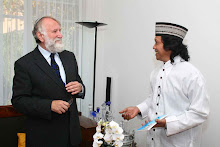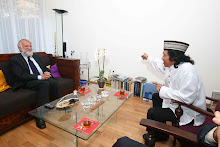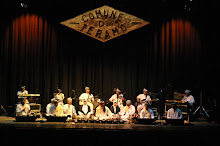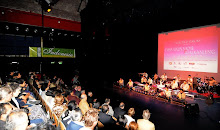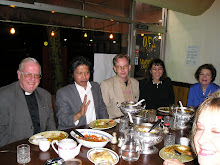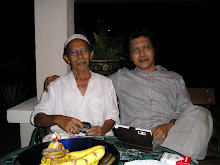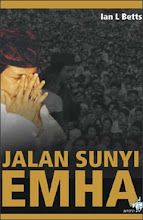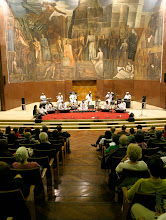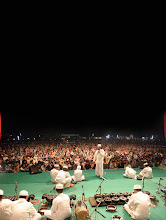March 21st – April 12th, 2005
This second visit of Emha Ainun Nadjib and Kiai Kanjeng to the United Kingdom was on the invitation of The Muslim News to lend a unique cultural performance to the presentation of awards to Muslim achievers of excellence in various fields that included medical science, sports, the sciences, economics and the arts in Europe.
The Muslim News Awards for Islamic Excellence
London, Wednesday, March 23rd, 2005
The Muslim News Awards for Excellence 2005 were held before an audience of about 600 special invitees at the Ball Room of the Inter-continental Hotel London. In attendance were three leaders of Muslims of Europe, three British cabinet ministers, a number of ambassadors, the award winners themselves and Chancellor Gordon Brown. As Chancellor of the Exchequer, Brown is second in importance in the UK only to Prime Minister Tony Blair. Following opening comments, which were made by several speakers, and the presentation of the awards, Novia Kolopaking led a stunning performance by Kiai Kanjeng.
Kiai Kanjeng had arranged their music specifically for the occasion. The Awards Committee had asked Kiai Kanjeng to present two Qur’anic recitalists to open the concert. Two of their vocalists, Nia Kurniawati and Yuli Astutik, complied with the request. Yuli recited a passage from Islam’s Holy Book prosaically in the murattal style, while Nia recited hers beautifully in the qiroah style, poetically, befitting her status as the Second National Champion.
Immediately thereafter Kiai Kanjeng started their performance with a long musical composition entitled Tasbih Music. A tasbih is a set of prayer beads, much like a rosary, used by Muslims to count their repetitions of dzikir phrases, or utterances in remembrance of Allah. The music comprehensively explored various phenomena: musical elements from the east and the west, from both the traditional and the modern. There were also poetry readings in English by Novia Kolopaking, a number of wirid (chants), several shalawat (songs in praise of the Prophet Muhammad) and a section of terbang rancak (music with tambourine-like instruments). Kiai Kanjeng’s performance also included excerpts from the dynamic songs of legendary Egyptian songstress Ummi Kultsum, the adzan (or Islamic call to prayer) and other mucsical numbers. The vocalists for the performance consisted of Islamiyanto, Imam Fatawi, Nia Kurniawati and Yuli Astutik.
Novia Kolopaking read the poems Bow to Allah, If a Stone is Laying on the Street and Prostrate Yourself and sang Heart Healing and Longing for Thou in a series of arrangements made specifically by Kiai Kanjeng for the occasion, the presentation of awards to sixteen Muslims for outstanding achievement in Europe. The awards were conferred to achievers in medical and other sciences, social service, even sports. Danny Williams, a Muslim boxer who knocked Mike Tyson out in round four was among award recipients that evening.
The Indonesians in the audience probably remembered how Danny William had prostrated himself after having knocked out Tyson, approached him, hugged him and said, “I did not defeat you. It was you who handed me the victory.” It was a comment from a champion mixed with religious modesty. Danny did not feel himself to have won, so he did not suffer “big-headedness” as a result of the victory. When he received the award he made a short speech:
“I am very amazed at receiving this award because when I defeated Tyson I was not very serious about my victory.”
Reporting from the UK, the group wrote at the time that their performance had been ‘unusual’. They ascribed this to two key reasons. Firstly, they were concerned that they would be performing before an audience that included two groups potentially unfavourable towards Islamic music. On one hand there there were Muslims who consider music to be taboo in Islam and on the other, there were westerners whose opinions were informed by a mass media that often portrayed Islam as exclusive and who potentially may have been prejudiced against it.
Secondly, their performance had been led by a woman; and a woman in the later stages of pregnancy. At the conclusion of the performance a number of Muslim women community leaders, including a number from Africa, hugged Novia, saying they were excited and very proud of her, calling her “a woman who exercised her leadership without conflict”. She received a rousing appreciation and applause from the audience.
Unusual? Yes, perhaps. Controversial? Maybe. But groundbreaking? Definitely.
The musical presentation of Kiai Kanjeng could be considered pioneering in many other respects. For example, there were Kiai Kanjeng’s global musical explorations, their unique and intelligent arrangements and the sheer artistic courage required to advance cultural creativity among Muslims. In a substantial sense, the efforts of Kiai Kanjeng were truly phenomenal.
This was the first time, in five years of annual award presentations, that a musical group from Indonesia had been invited to this prestigious event. It was a historical event. The works of Kiai Kanjeng are not merely pioneering in advancing a ‘new culture’ in the Islamic world, but they have artistic qualities that can be placed on a par with other great musical works of the world. This is amply demonstrated by their concerts during tours of Europe as well as on their earlier tours of Egypt, Malaysia and Australia.
Chancellor Gordon Brown spoke for about 40 minutes after the performance of Kiai Kanjeng and quoted three sayings of the Prophet Muhammad on social cohesion and the importance of tolerance. He said he was very fortunate to have had the opportunity to attend a performance of Indonesian music that promoted such freedom and diversity.
Brown said that the musical expression of Kiai Kanjeng was an example of the “cohesion of a social power” referred to in the saying of the Prophet Muhammad “Almuslimu lilmuslimi kalbunyan yasyuddu ba’dhuhum ba’dla”, a Muslim and another, a man and his fellow man, one and the other are mutually strengthening factors. Furthermore, emphasised Brown “the true community is one where if some of its members are afflicted by illness, the other members feel the pain too”.
He said the diversity of nuances and the cohesion of global pluralism reflected by the pattern of arrangements and the sound of the music of Kiai Kanjeng aptly picture the ideals we are fighting for and which we should achieve in the world of today and of tomorrow. “Islam,” said Brown, “contains principles of teaching and knowledge that inspire the development of humanity on the earth for the future.”
In addition to Gordon Brown, a further two British cabinet ministers attended the performance and also made speeches prior to presenting the awards. The event was full of customary Islamic phrases such as Assalamu’alaikum (a greeting of peace) and Bismillah (a profession of believers in Allah’s name). There were Muslim leaders from throughout Europe, other British officials, ambassadors and prominent figures from various fields. From Kiai Kanjeng’s perspective, the evening was likened to a fisherman who casts his net wide and is rewarded with a large catch.
Eddy Pratomo, representing the Indonesian Embassy and instrumental in arranging for Kiai Kanjeng to perform in London, said:
“All in all this is not just art, it is more than that. This is a fight to for the red-and-white (the merah-putih or national flag of Indonesia)…that political diplomacy should be expanded to include cultural diplomacy as Emha Ainun Nadjib and Kiai Kanjeng have demonstrated…a diplomacy that has proven itself capable of attaining objectives and reaching an effectiveness that cannot be achieved by ordinary diplomacy.”
Following the performance, Novia Kolopaking, the leader of the Kiai Kanjeng ensemble, was congratulated by leaders from various countries. Two organizations invited Kiai Kanjeng to visit Britain again.
In addition to shows in Aberdeen, Kiai Kanjeng would also visit Berlin, Rome, Naples and Teramo with the theme:
“Music is the way - smiles without pretence for warmth and friendship that never ends”Emha wrote from the Italian tour that the last days of Pope John Paul II had been very touching. The congregation had witnessed how the Pope fought hard to entice even the fewest words from his throat and mouth. High on the balcony of the Vatican Palace he succeeded in moving both his hands as high as his head. Actually, wrote Emha, he moved his hands as if in an effort to speak to his congregation.
The Pope struggled several times to say just one or two words. But not a single word came out. Finally he made the sign of the cross, a signal that went straight to the hearts of his people; and much more effectively than any words he could have said. Then, he was taken away to receive intensive care. That was the start of his long journey to the hereafter, the true, eternal life, free from the illusory material world.
“I don’t want to go on discussing death, since almost everyone thinks that death is real, the way worldly life is. Now Pope John Paul II understands exactly which is more real: death, or life after death, or the worldly life. We have not reached the Pope’s state. We are still indulging ourselves, even deluding ourselves in speculation as to the nature of life and death. And, in our speculation, we do not forego the foolish acts of stealing, tackling others, hating others, envying the good fortune of others, and these foolish acts we persist in doing until the very last minutes of our lives when we enter the agony of death.”
Emha wrote that the Pope was a figure of morality, not one of politics. The Papacy may be likened to the Council of Fatwa (Religious Council) in Islam. In the world of Shia, an Ulama or Muslim cleric may attain the rank of Mullah, then of Hujatul Islam and finally even, Ayatollah, the highest rank of leadership in Shia Islam, such as the Ayatollah Khomeini.
Emha had been very impressed by the moral strength and personality of this Pope, who had once been Karol Wojtyla from Poland, a witness to the cold war in the Eastern Bloc, who in the few last decades expounded his views on universal humanitarian issues, international politics, the map of global conflicts and the crucial problems of the world, including those involving Islamic peoples.
Millions of young people felt an affinity of the heart with this Pope. It seems that they are closer to Pope John Paul II than they are to their own religions. It was as if the Pope was able to give them greater enlightenment than that afforded by their own faiths. This closeness, this love, was demonstrated when millions of people flocked to Rome to attend his funeral.
Emha would later write that in his opinion, the show at the Conservatorio Di Musica San Pietro A Majella, Naples, could be called the climax of all performances given by Kiai Kanjeng in this second tour of Europe.
In London he wrote they had worked hard to ‘tame’ their creativity in order to properly address the international air of Islamophobia that they perceived to be a dominant cultural force. In Aberdeen they devoted their talents to building the human and cultural relationship between the Indonesian and the Scottish peoples. In the World Hall of the German Foreign Office they had adapted their music to afford a sense of political and cultural diplomacy. In Rome they offered their creativity to the beauty of religious tolerance, particularly to the solemn atmosphere following the death of Pope John Paul II.
Just as Kiai Kanjeng arrived in Rome, the Pope fell ill. Prior to the Pope’s funeral Kiai Kanjeng had to leave Rome – after two shows – for the old town of Teramo, for a performance organized by the Mayor. Then, Kiai Kanjeng staged a show in Naples. This climactic show, Emha wrote, was very successful.
“I am afraid nobody would believe it even if it was reported,” he said.
Then, because Rome was closed for the funeral, Kiai Kanjeng had to go to Pescara in order to fly to London. In London the group were only able to stay one night. It was difficult to arrange a further performance as there were appointments arranged with Ahmad Versi from the Moslem News, with Yusuf Islam and with friends from the BBC. Kiai Kanjeng would then travel to Yogyakarta, while Emha was to travel to Aceh to commemorate the 100th day of the tsunami there.
While in Germany, Emha sent an email report back to Indonesia from the computer of Mas Pipit Rukhiyat, “a close friend since our vagabond days in Berlin in 1984-1985”. There, Emha and Pipit discussed the workshop themes:
Eradication of corruption in Indonesia starting with the adaptation of Brazilian and Bolivian models.
Dissemination of an idea of a constitution providing for separation of authority between the State and the Government.
The previous evening, Kiai Kanjeng met the Indonesian community in Berlin in a in a get-together at the Museem Dahlem Theatre where they all exchanged banter, anecdotes and other amusing stories and laughs. Within a few days Kiai Kanjeng would stage a formal show at the auditorium of the Foreign Office where the audience was to include 350 German high officials, ambassadors, and 100 Indonesians.
Strathcona Hall, The Rowett Institute Aberdeen, Scotland, Friday, March 26th, 2005
Cultural Diplomacy in Action
Earlier, Kiai Kanjeng and Emha had performed in Aberdeen, Scotland. This was the headline that opened press materials:
World famous Indonesian Gamelan band performs at Aberdeen’s Rowett Institute to raise funds for the Indonesian Children’s Relief Appeal
Publicity materials reported that the 15-strong Kiai Kanjeng Gamelan group were to perform two concerts at Aberdeen’s Rowett Research Institute on Saturday March 26th, 2005in aid of the Indonesian Children's Relief fund for the orphaned children of Aceh, Indonesia (recently struck by the Asian Tsunami).
The concerts were performed in front of an audience of Aberdeen’s Indonesian community and associated members of the Scottish research community. Tickets were limited and very quickly sold out. According to the publicity materials:
“…the group use traditional Javanese percussion to perform a range of songs and music including pop, blues, jazz and even Chinese music. The group also performs poetry and prayers. Kiai Kanjeng are on their second European tour which includes concerts in Berlin, Rome, Naples, Turin and London. Saturday’s concert at the Rowett Institute is being sponsored by the Indonesian Embassy in London.”
Dr Rusmana Ningrat, who had organized the event, is a research scientist at the Rowett Research Institute. He said:
“This concert is a very exciting event for Aberdeen’s Indonesian community and all our friends. I think that one of the reasons the Indonesian Embassy has supported it is in recognition of the large amount of aid which has already been raised by the people of Aberdeen to help the victims of the Tsunami. We are very grateful to the Rowett Institute for allowing us to hold the concert in Strathcona Hall, which was originally built to foster links between Rowett scientists and colleagues working overseas."
Emha concluded this report by writing that there were “many lessons to learn” from the European tour, of the various ‘mysteries and unusual events’ experienced during the tour; the temperatures, the weather, and the necessity of transporting the large volumes of equipment required by Kiai Kanjeng; of the performance at the Conservatory, the Mecca of classical music, of Naples and of the situation following the death of Father Karol Wojtyla or Papa John Paul Secundo.
In Aberdeen, Scotland, Europe’s oil capital, it could be clearly felt that the arrival of Kiai Kanjeng was not just a major arts event but a cultural and humanist event, and essentially a political event too in that it had substance, both implicit and explicit.
[1]The presence of Kiai Kanjeng allowed those Scots who attended to immerse themselves in the enjoyment of inter-cultural exchange and humanity, which made all kinds of political sentiments about ‘Indonesia’ and the psychological issue of “Islamophobia” appear trivial and unimportant. The atmosphere in the forum demonstrated the ‘global intimacy’ that could be achieved among people without the barriers of nationality, politics, religion or anything else for that matter.
“World politics is breaking up the global community,” said Emha. “Economic capitalism reduces people to fundamental ideologies and a range of mainstream values that drive divisions between them, estranging them behind artificial barriers. But in our music this evening we will discover the enjoyment of being together”.
Emha gave the example of bagpipe music, an important component of traditional Scottish culture. Renowned piper Mr. Duncan McPherson had accompanied Kiai Kanjeng in their rendition of Amazing Grace. Kiai Kanjeng had seamlessly taken up the melody without altering the notation, pitch or key, and used it as the basis for a medly of traditional songs from Madura (East Java), Aceh and Timor.
Aesthetically speaking, it was clear that the distance between the East and the West was, in musical terms, a minor one. Kiai Kanjeng were able to find connections between and unity among cultures from all over the world. It was very easy for Kiai Kanjeng to perform the traditional Scottish song Auld Lang Syne because the melody had already been adopted by the communities of Indonesia. The material prepared for Kiai Kanjeng’s performances for audiences in Germany and Italy, where they were due to travel next, was just as well prepared.
The audience for Kiai Kanjeng’s performance in Aberdeen’s Rowett Institute Strathcona Hall was almost entirely Scottish, though there were a number of Indonesians present who were resident in Aberdeen. The performance was divided into afternoon and evening slots so that as many as possible would have the opportunity to attend. The Indonesians who were able to attend, aside from those on the organising Committee, included students or oil company employees. They were joined by friends, many of whom had made a special trip from Glasgow or Edinburgh in order to attend.
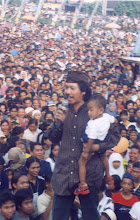


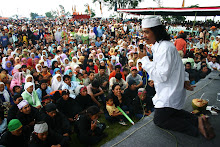



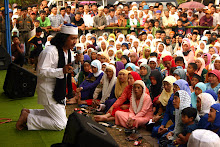


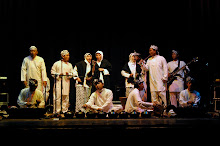



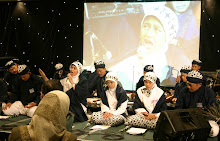
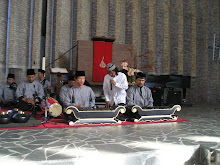
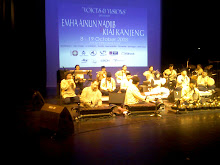

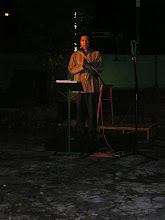
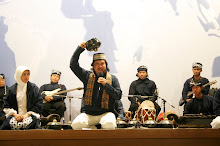


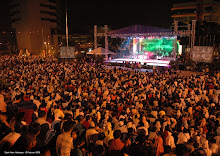
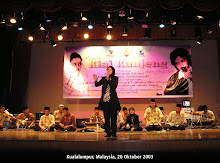
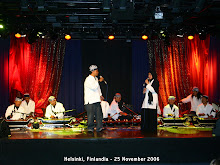.jpg)

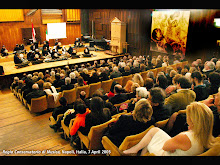

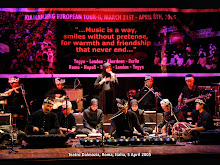
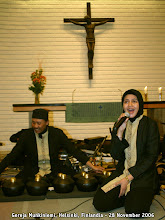.jpg)

.jpg)
